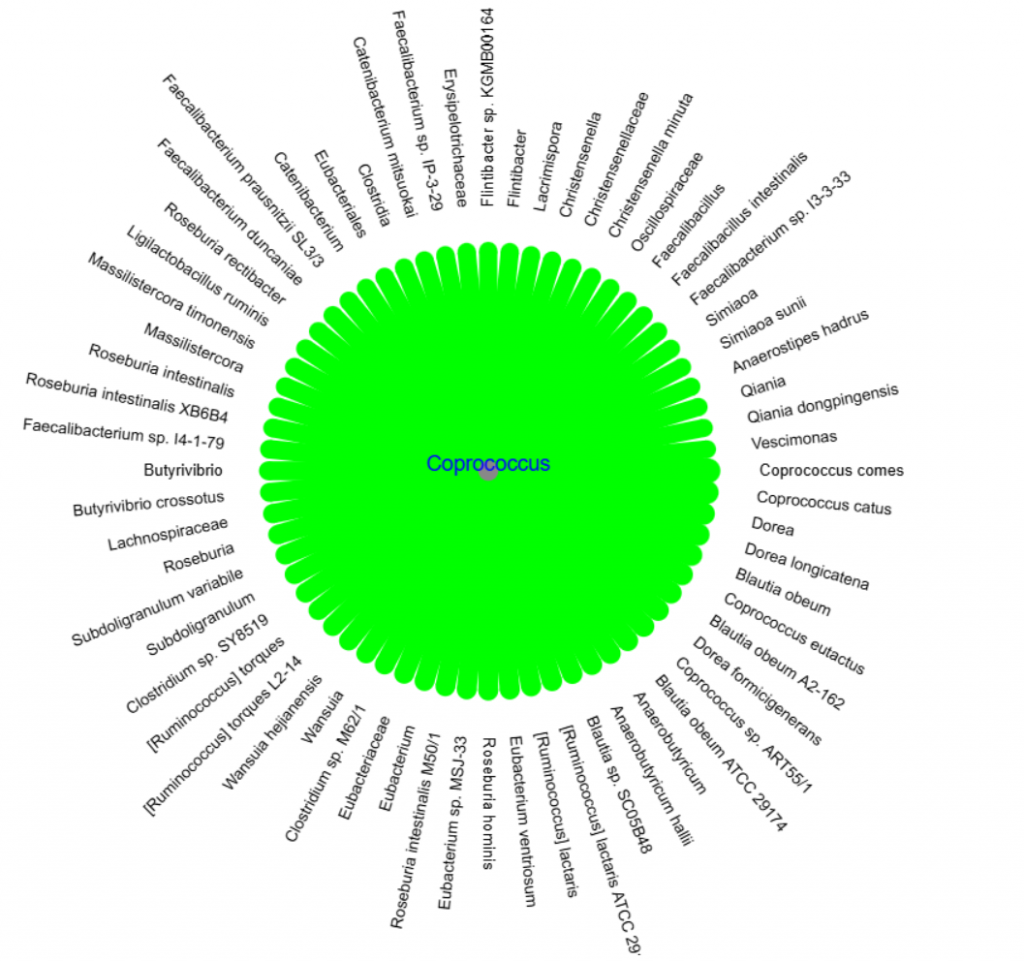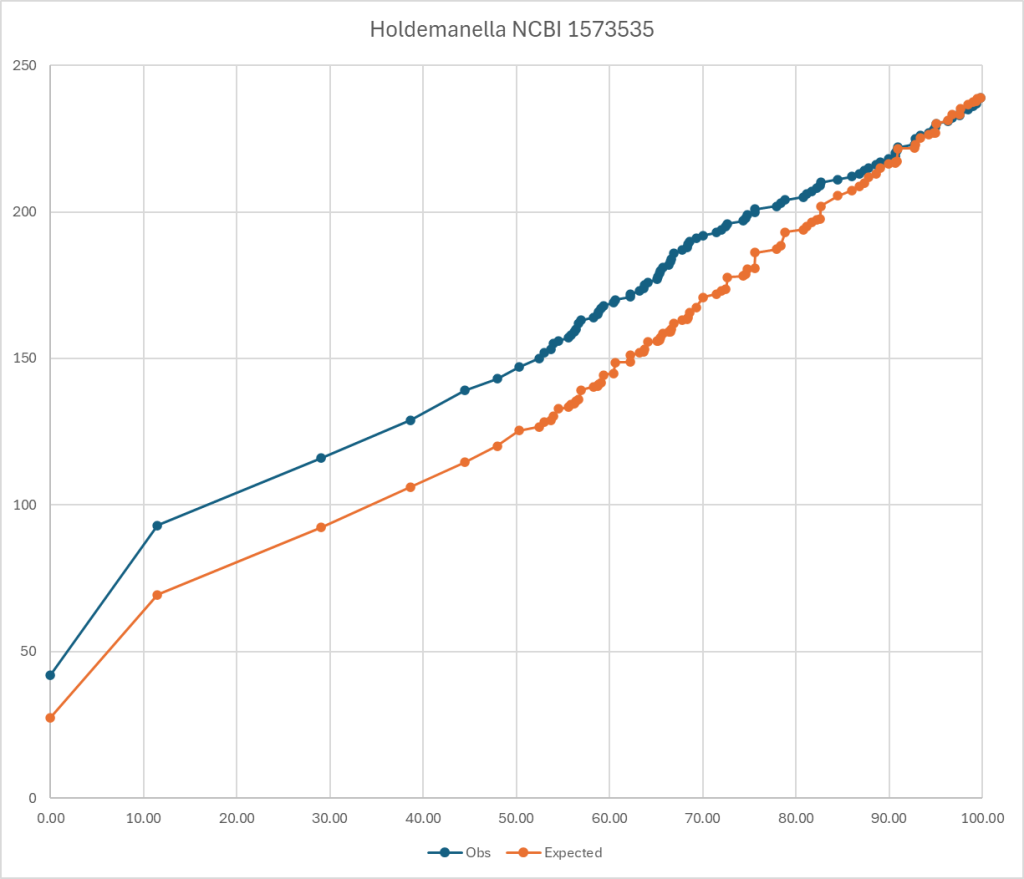What is the difference between a Species and a Strain? To understand this, view Species as “dogs” and strains as specific types. Is picking a Chihuahua as a police dog a good choice, or a St. Bernard suitable for someone with disability living in a one room apartment?
The chart below shows different aspects of different strains for Lactobacillus Reuteri. When you buy a probiotic names “Lactobacillus Reuteri”, it is unlikely which species if was obtained from is specified on the bottle. If it was not from a human, it is very unlikely that it will reproduce or take root in your body.
Probiotic manufacturers and packagers are focused on making money. They will ask for the cheapest source for a probiotic that they expect to be able to sell for the greatest profit. Human source is not a factor, cheapness is!
I have known people that are histamine sensitive that are fine with one brand of Lactobacillus Reuteri but get sick from another brand…. Looking at the chart below, the answer is obvious: One has a histamine producer and one does not.

Researched but not for sale
This morning I was asked about Bacteroides fragilis BF839 which is cited in several studies on the US National Library of Medicine. Most of the studies are from 2024 or 2025. At present, it is not for sale anywhere and I do not expect it to be for five(5) years at least because of approval processes. Given the authors’ location, I expect it will be first available in China.
Researched and Stain is for sale
Several years ago I set up a free page listing those available (somewhere in the world). I also automated a weekly automatic scan of the US National Library of Medicine for any new studies using these strains. The page is kept up to date.
Occasionally, someone emails me about a new strain that has one or more studies associated. I add those to the list. If you find one that I missed, please email me!
The page allows searching across the studies abstracts for key words. For example, if you are interested in Autism, just enter that and click search. The page will then show the retail brands with links to the studies.


The intent of the page is discourage random trial of probiotics which has no effect (except on bank accounts).
List of Strains with name of product or seller
At present we are at 156 different strains. These are listed below.
- Akkermansia muciniphila WB-STR-0001: Pendukum Glucose Control
- Aspergillus oryzae NK: strong wakamoto w
- Bacillus clausii MCC 0538: Biome Ultra
- Bacillus clausii N/R: Enterogermina
- Bacillus clausii O/C: Enterogermina
- Bacillus clausii SC-109: MegaSporebiotic
- Bacillus clausii SIN: Enterogermina
- Bacillus clausii T: Enterogermina
- Bacillus coagulans ATCC 5856: Nature’s Sunshine Bacillus Coagulans,
- Bacillus coagulans DSM 17654: Biome Ultra
- Bacillus coagulans GBI-30: Schiff® Digestive Advantage® Daily Probiotic
- Bacillus coagulans SC-208: MegaSporebiotic
- Bacillus coagulans SC208: Eded 3 in 1
- Bacillus Coagulans SNZ1969: Jetson FIT
- Bacillus coagulans Unique IS-2: Optibac Probiotics Adult Gummies Probiotics
- Bacillus indicus HU36: MegaSporebiotic
- Bacillus licheniformis DSM5749: PrecisionBiome
- Bacillus mesentericus (subtilis) TO-A: AOR, Probiotic 3
- Bacillus subtilis ATCC SD 7280: Biome Ultra
- Bacillus subtilis BG01-4TM: VERNX
- Bacillus subtilis DE111 : Probiotic w/ DE111
- Bacillus subtilis DSM17299: PrecisionBiome
- Bacillus Subtilis HU58: MegaSporebiotic
- Bacillus Subtilis MB40: Country Farms Super Flora Probiotics
- Bacteroides xylanisolvens DSM 23964: AVI-1 (pending on market)
- Bifidobacterium adolescentis IVS-1: Synbiotic Health ISV-1
- Bifidobacterium adolescentis PRL2019: Gabapral
- Bifidobacterium animalis ssp. lactis 420: UltraFlora® Control
- Bifidobacterium animalis ssp. lactis CUL-34 (NCIMB 30153): Genestra Brands – HMF Neuro Powder
- Bifidobacterium animalis subsp lactis HN019: Optibac Every Day Max
- Bifidobacterium animalis subsp. lactis CECT 8145: Culturelle Healthy Metabolism + Weight Management Supplement
- Bifidobacterium bifidum BB-06: Custom Probiotics
- Bifidobacterium bifidum CUL-20 (NCIMB 30172) : Genestra Brands – HMF Neuro Powder
- Bifidobacterium bifidum G9-1 (BBG9-1): Phillips’® Colon Health
- Bifidobacterium bifidum HA-132: Human Probiotics
- Bifidobacterium bifidum MIMBb75 (SYN-HI-001): IRRITABLE COLON PRO KIJIMEA
- Bifidobacterium bifidum W23: Ecologic® Barrier for Metabolic Health
- Bifidobacterium breve HA-129: Human Probiotics
- Bifidobacterium Breve LMG 11613: Bioflora (Mexico)
- Bifidobacterium breve M-16V: Optibac Probiotics Professional
- Bifidobacterium breve PRL2020: PharmExtracta / Brevicillin Stick
- Bifidobacterium lactis BB-12: Nestlé
- Bifidobacterium lactis Bi-07: UltraFlora® Balance
- Bifidobacterium lactis Bl-04: Optibac Probiotics Every Day MAX Probiotics
- Bifidobacterium lactis BL-4: Custom Probiotics
- Bifidobacterium lactis W51: Ecologic® Barrier for Metabolic Health
- Bifidobacterium lactis W52: Ecologic® Barrier for Metabolic Health
- Bifidobacterium longum 1714: Zenflore®
- Bifidobacterium longum 35624: Align
- Bifidobacterium longum BB536: Probiotic Pro Bb536
- Bifidobacterium longum BL-05: Custom Probiotics
- Bifidobacterium longum ES1: PharmExtracta / Gliadines buccal stickpacks
- Bifidobacterium longum MM-2: Phillips’® Colon Health
- Bifidobacterium longum R0175: Calm Biotic®
- Bifidobacterium longum ssp. infantis R0033: Human Probiotics
- Bifidobacterium longum ssp. longum HA-135: Human Probiotics
- Bifidobacterium longum subsp. infantis Bi-26: Custom Probiotics
- Bifidobacterium longum subsp. infantis NLS: Life Start 2
- Bifidobacterium longum Subspecies infantis Strain EVC001: Evivo® Infant Probiotic Powder
- Bifidobacterium longum W108: Ecologic® Relief
- Bifidobacterium longum W11: PharmExtracta / Bowell
- Clostridium Butyricum MIYAIRI: Miyarisan
- Clostridium butyricum TO-A: AOR, Probiotic 3
- Clostridium butyricum WB-STR-0006 : Pendukum Glucose Control
- Enterococcus faecalis T-110: AOR, Probiotic 3
- Enterococcus faecium L3: PharmExtracta / INatal Sachets
- Enterococcus faecium SBS 1: Shin Biofermin S
- Enterococcus faecium SF 68: Bioflorin
- Enterococcus faecium W54: Ecologic® AAD
- Escherichia coli , Laves strain 1931: Colibiogen
- Eubacterium hallii WB-STR-0008: Pendukum Glucose Control
- Hafnia alvei HA4597: SymbioLife ® Satylia
- Heat Killed Lactobacillus plantarum L-137: Swanson Immunobiotic Immuno-LP20
- Lacticaseibacillus paracasei subsp. paracasei CNCM I-1518: DanActive
- Lacticaseibacillus rhamnosus HN001: Optibac Probiotics Babies & Children Probiotics
- Lactobacillus acidophillus CUL-21 (NCIMB 30156): Genestra Brands – HMF Neuro Powder
- Lactobacillus acidophilus ATCC 4356: resB® Lung Support
- Lactobacillus acidophilus CL1285: Bio-K+
- Lactobacillus acidophilus CUL-60 (NCIMB 30157): Genestra Brands – HMF Neuro Powder
- Lactobacillus acidophilus HA-122: Human Probiotics
- Lactobacillus acidophilus LA-14: Custom Probiotics
- Lactobacillus Acidophilus LA1: Flora Pro Fem with Cranberry
- Lactobacillus acidophilus NCFM: UltraFlora® Balance
- Lactobacillus acidophilus W22: Ecologic Performance
- Lactobacillus acidophilus W37: Ecologic® Barrier for Metabolic Health
- Lactobacillus acidophilus W55: Ecologic® Allergycare
- Lactobacillus brevis W63: Ecologic® Barrier for Metabolic Health
- Lactobacillus casei LBC80R: Bio-K+
- Lactobacillus casei LC-11: Custom Probiotics
- Lactobacillus casei R0215: PharmExtracta / INatal Sachets
- Lactobacillus casei Shirota: Yakult
- Lactobacillus casei W56: Ecologic® Barrier for Metabolic Health
- Lactobacillus casei W79: Ecologic® Relief
- Lactobacillus crispatus LbV 88 (DSM 22566): AZO Complete Feminine Balance
- Lactobacillus fermentum ME-3: Reg’Activ Essential ME-3
- Lactobacillus gasseri KS-13: Phillips’® Colon Health
- Lactobacillus gasseri LbV 150N (DSM 22583): AZO Complete Feminine Balance
- Lactobacillus Gasseri LMG 266: Bioflora (Mexico)
- Lactobacillus gasseri SBT2055: gasseri SP strain capsule
- LACTOBACILLUS HELVETICUS L10: LACTOBACILLUS HELVETICUS LAFTI® L10
- Lactobacillus helveticus R0052: Calm Biotic®
- Lactobacillus jensenii LbV 116 (DSM 22567): AZO Complete Feminine Balance
- Lactobacillus Kefiri LKF01 (DSM 32079) LKEF : Kefibios
- Lactobacillus paracasei (case)i 431: For daily immunity
- Lactobacillus paracasei 8700:2: UltraFlora® Cold Support
- Lactobacillus paracasei F-19: Optibac Probiotics For Women Probiotics
- Lactobacillus paracasei Lpc-37: Custom Probiotics
- Lactobacillus paracasei W20: Ecologic® AAD
- Lactobacillus plantarum 299v: Jarrow Formulas Ideal Bowel Support
- Lactobacillus plantarum DR7: SymbioLact ® Pro Sleep
- Lactobacillus plantarum HEAL9: UltraFlora® Cold Support
- Lactobacillus plantarum Lp-115: Custom Probiotics
- lactobacillus plantarum LP45: Natealth
- lactobacillus plantarum ps128: Neurobiotique PS128
- Lactobacillus plantarum W1: Winclove Senior
- Lactobacillus plantarum W21: Ecologic Travel
- Lactobacillus plantarum W62: Ecologic® AAD
- Lactobacillus reuteri ATCC PTA 5289: BioGaia® ProDentis
- Lactobacillus reuteri DSM 17938: BioGaia®
- Lactobacillus reuteri RC-14: RepHresh™ Pro-B™ Probiotic
- Lactobacillus rhamnosus CLR2: Bio-K+
- Lactobacillus rhamnosus GG: Culturelle®
- Lactobacillus rhamnosus GR-1: RepHresh™ Pro-B™ Probiotic
- Lactobacillus rhamnosus HA-111: Human Probiotics
- Lactobacillus rhamnosus LbV96 (DSM 22560): AZO Complete Feminine Balance
- Lactobacillus rhamnosus Lcr35: Provacare®
- Lactobacillus rhamnosus Lr-32: Custom Probiotics
- Lactobacillus rhamnosus LR1: Flora Pro Fem with Cranberry
- Lactobacillus rhamnosus R0011: Flora Pregnancy Care Probiotic
- Lactobacillus rhamnosus W71: Ecologic® AAD
- Lactobacillus Sakei pro-Bio-65: Kimchi Power
- Lactobacillus salivarius HA-118: Human Probiotics
- Lactobacillus Salivarius Ls-33: Custom Probiotics
- Lactobacillus salivarius UCC118: UltraFlora® Integrity
- Lactobacillus salivarius W24: Ecologic® Barrier for Metabolic Health
- Lactocaseibacillus rhamnosus ATCC 53103: resB® Lung Support
- Lactococcus lactis JCM5805 (L. lactis plasma): IMMUNOFLORA
- Lactococcus lactis LL-23: Custom Probiotics
- Lactococcus lactis W19: Ecologic® Barrier for Metabolic Health
- Lactococcus lactis W58: Ecologic® Barrier for Metabolic Health
- Lactoplantibacillus plantarum ATCC BAA-793: resB® Lung Support
- Limosilactobacillus reuteri SD5865: Natures-Way-Primadophilus-Reuteri-Pearls
- Mutaflor (Escherichia coli strain Nissle 1917): Mutaflor (Canada, Australia, Findland, Germany)
- Oxalobacter formigenes DSM 4420: TrueMeds
- Pediococcus Acidilactici NRRL B-50517: Imagilin Nutri-5051
- Prescript Assist(multi species): Prescript Assist (dispute on formula change)
- Propionibacterium freudenreichii shermanii : Optim Propionibacter
- Saccharomyces boulardii (Klaire Labs): Klaire Labs Saccharomyces boulardii
- Saccharomyces boulardii CNCM I-745: Florastor®
- Saccharomyces Boulardii THT 500101: Bioflora (Mexico)
- Saccharomyces cerevisiae boulardii CNCM I-1079: Pure Encapsulations
- Streptococcus salivarius K12: BLIS ThroatHealth Oral Probiotics
- Streptococcus thermophilus ST-21: Custom Probiotics
- Symbioflor 1: German Apotheke by Paul’s Mart
- Symbioflor 2: German Apotheke by Paul’s Mart
- VSL3 / Visbiome / De Simone Formulation: Alfasigma USA, Inc.
Safest Product for Correct Identification
These strains are usually under legal protection and thus the manufacturer has a vested (financial) interest to make sure that “what is advertised is delivered”.
Why is this important, just look at some of the literature
- Microbiological Quality and Antimicrobial Resistance of Commercial Probiotic Products for Food-Producing Animals [2024]
- 64.4% were incorrectly labeled in either number of viable cells or bacterial species
- 51.6% exhibited resistance to at least one antimicrobial agent
- 26.8% had a lower number of viable cells than their label claims, No viable Lactobacillus was found in some products
- 57.8% comprised other species rather than those claimed on the contents
Your first choice should be the probiotics that are most likely to be as advertised and has been studied for the symptom of condition that you are interested in.





















Recent Comments